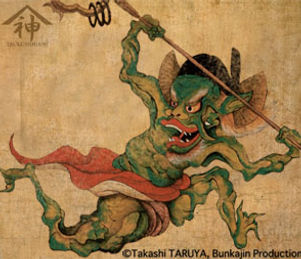CONCEPT




In the same way that Celtic myths contain their fairies and Chinese legends their grotesque creatures, Japanese fairy tales are inhabited by supernatural beings known as yōkai. Many have become popular characters, such as one-eyed demons (hitotsume kozo) or konaki-jijii who deceive people by imitating the sound of crying babies. Some yōkai appear as strange phenomenon, with a popularity found in slightly scary fairy tales, manga, animated films, and full-length features.
Portraying uncanny supernatural spirits and their place in our lives, Takashi Taruya focuses on a species of yōkai, tsukumo-gami, who inhabit human objects with evil or mischievous intent, often with comic results.
They spring from an old belief that supposedly inanimate objects like tools or vessels used for a long time eventually develop a spirit of their own and become yōkai who do wicked or funny things to people. ‘Tsukumo’ is written using the characters for ‘99’ and is used in this context to indicate ‘many types’ or almost 100 years, meaning ‘a long, long time’. The Japanese people have a custom of expressing gratitude and venerating objects, such as chests of drawers, sliding doors, saucepans and even chopsticks, that have been part of their daily lives for many years. This is what makes for comic juxtaposition in such delightful, uncanny tsukumo-gami creatures as the one-legged, one-eyed umbrella or washbowl with arms and legs.
Living within today’s mass-consumption society, Taruya found himself inspired by the traditional Japanese belief in the existence of tsukumo-gami. Contemplating the warped values of a society, in which objects are not appreciated but treated as disposable, thereby adding to the destruction of the environment, he underwent an almost religious awakening as both an artist and an individual, leading him to portray the spirit of these tsukumo-gami in his work. The result was that he turned the tsukumo-gami and yōkai, which Japanese artists have repeatedly produced over the last 700 years, as his motifs, combining the latest materials and techniques with traditional gold leaf to bring them back to life in his own unique way. TARUYA speaks of them as follows: ‘I do not take a condescending position, warning people not to overconsume, rather, the message embodied in my tsukumo-gami is that we should consume in a clever, unwasteful fashion and recycle our limited resources. That is why I do not depict them as awe-inspiring gods, but rather as humorous and cute.’
In TARUYA’s work the ‘yōkai and tsukumo-gami’ can be seen living active lives in the convenience stores, cafes and gas stations that we use in our daily lives. The viewers find themselves crossing the borders of time to be drawn into an imaginary world. The active spirit and humor that imbues his work gives us, living in contemporary society, hope for the future.

BIOGRAPHY
Takashi TARUYA
Born in Japan’s Kagoshima Prefecture in 1974. He studied lettering while still in high school, becoming so proficient that he was able to work part-time writing signboards. Later, he produced reproductions of works by Michelangelo and Botticelli while studying oil painting at the Kyoto University of Art & Design and this experience provided him with the necessary skills to create huge murals and ceiling paintings (in Australia and New Zealand). While working overseas on these murals, he became interested in paintings of yōkai, particularly tsukumo-gami, painted using traditional Japanese techniques and began to work on a reproduction of a classic picture scroll. He then went on to teach himself the technique of applying gold leaf to pictures, employing this in his own work. He held his first solo exhibition in 2009 and ever since he has built a reputation for producing unique works depicting
the world of the tsukumo-gami.
NEWS



Japanese Yōkai

Japanese yōkai are supernatural beings that appear in old folk tales; they come in numerous different types, from demons to foxes, and each possesses a different character. Some, like the water sprite, Kappa, or the long-nosed goblin, Tengu, incorporate aspects of both humans and animals. One famous work, ‘Ezu Hyakki Yagyō’ (The Illustrated Night Parade of a Hundred Demons) by the woodblock print artist, Sekien TORIYAMA (1712-1788), is a series of pictures portraying various yōkai. During the 1960s, a manga, ‘GeGeGe no Kitarō’, by Shigeru MIZUKI featured various Japanese yōkai and was a huge hit, later becoming a popular anime and giving rise to numerous characters. Recently, ‘Yo-Kai Watch’ has become a hit manga and numerous items featuring monster motifs have become very popular. Today, yōkai have become an accepted facet of Japan’s pop culture, leading to a yōkai boom in the U.S. and the word ‘yōkai’ becoming part of the English language, together with ‘otaku’ and ‘kawaii’.








